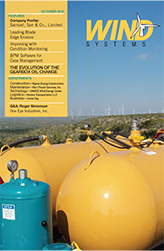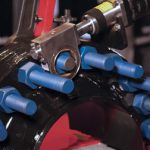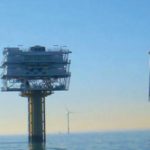Houston, Texas-based EDP Renewables North America (EDPR NA), is the third largest renewable energy company in the United States. We design, develop, construct and operate 28 wind farms throughout North America, and have developed more than 3,400 megawatts (MW) of wind energy. Our parent company, which operates facilities in Europe and South America, is the third largest wind energy company in the world.
At EDPR NA we are committed to enabling a clean energy future for the U.S. Current market trends, including increasing economic efficiency and acceleration of technological developments in renewable energy, support that vision. With a sound development pipeline, first class assets and market-leading operating capacity, we have undergone exceptional development in recent years. In addition, we are committed to employing the most innovative strategies and technologies in the industry to maximize our company’s performance and the value we deliver to our customers.
Turbine Performance – The Key to Wind Energy Competitiveness
According to the American Wind Energy Association’s First Quarter 2012 Market Report, the United States wind industry has added more than 35 percent of all new generating capacity over the past five years, second only to natural gas, and more than nuclear and coal combined. Today, U.S. wind power capacity represents more than 20 percent of the world’s installed wind power. The report also states that the U.S. wind industry represents not only a large market for wind power capacity installations, but also a growing market for American manufacturing. More than 470 manufacturing facilities across the U.S. make components for wind turbines, and dedicated wind facilities that manufacture major components such as towers, blades and assembled nacelles can be found in every region.
So wind energy has become a serious contributor to our national energy market, and the economy itself. This growth has been fueled in part by rapid improvements in wind turbine technology. However, despite these technological advances, competitive market pressures continue to demand that wind energy suppliers pursue innovation throughout their organizations to operate as efficiently and reliably as possible.
Like most wind energy companies, EDPR NA’s assets are in very remote locations dispersed across the United States. Modern technology enables companies to accurately forecast wind speeds and generation potential, but the industry as a whole must still grapple with prioritizing performance issues based on severity and wind patterns, communicating knowledge across a geographically dispersed organization, and the challenge of working around the availability of resources to schedule maintenance – a more dynamic process than what traditional energy generation sources face.
At EDPR NA, this relentless focus on performance improvement has led us to think of turbine issue management in terms of a Dynamic Case Management approach that links governance to operations to ensure that farms perform optimally while the wind is blowing.
Dynamic Case Management (DCM) is a term coined by global IT analysis firm Forrester Research. Forrester describes DCM as “a new way of thinking about how complex work gets done. For enterprises, DCM provides a transformational opportunity to take the drudgery out of work and enable high-value, ad hoc, knowledge work.” [1]
Forrester also said, “Functional and industry-specific packaged applications have worked well for well-defined, highly structured processes where volume, scale, and straight-through processing dominate system design. But these apps are difficult to change, appear increasingly less relevant, and form a barrier to innovation for companies in fast-moving industries like energy, healthcare, and financial services…These [industries] will leverage advanced dynamic case management (DCM) and business process management (BPM) suites. [2]
Our Approach to Dynamic Case Management
EDPR NA decided that embracing Dynamic Case Management would give us a competitive advantage in overall process management against our energy industry competitors. To prove the concept, the company initially focused specifically on the area of operations issue management. In using technology as an engagement vehicle to boost asset performance and maximize potential earnings, EDPR NA targeted three specific areas:
• Prioritization – Which problems are the most critical to address and solve first?
• Geographic Dispersion & Department Specialization – EDPR NA’s distributed assets require that our technical service department assist multiple wind farms from a centralized location.
• Knowledge Retention and Learning – given the pace of technological advancement, EDPR NA needed to document maintenance techniques, technical solutions, and best practices. Figure 1
Business Process Management Platform
To transform the industry-standard approach to case and process management, we designed a solution called COBRA (short for “COlaBoRAtion”). COBRA is a system for Dynamic Case Management built of a Business Process Management (BPM) software platform from Appian. The platform provides the typical core BPM capabilities, such as a comprehensive process engine, integrated business rules, event management and real-time analytics. Importantly, Appian also combines these with native mobility and social business collaboration. Taken in sum, these capabilities allow us to conduct fast and intelligent resolution of dynamic case scenarios.
Prioritization
In COBRA, issues encountered in remote sites are logged and assigned a priority for solution creation. COBRA uses real-time data about a problem’s size, combined with location-specific pricing information in order to determine the issue’s ability to affect the company’s bottom line. Through a complex algorithm, issues are assigned a score from 1-1000, which provides an absolute basis for objective comparison. We use this data to make transparent decisions about where to assign resources and focus improvement efforts.
Geographic Dispersion & Department Specialization
Wind turbines are highly complex machines, and problems that affect the fleet can have wide-ranging consequences. COBRA gives us a platform for structured collaboration around each issue, allowing departments to weigh in on the ramifications (technical, engineering, wind resource assessment, environmental, safety, procurement, legal, regulatory, and others) of problems, as well as their potential solutions. COBRA also assigns internal resources to each case that serve as a dedicated collaboration contact to assist on-site managers in reaching solutions. COBRA makes collaboration between disparate locations easy by also serving as a platform to discuss updates and new developments. Figure 2
Knowledge Retention and Learning
Not only does COBRA assign dedicated resources to serve as a point of contact for each case, but the system also centralizes the information generated, creating a constantly expanding knowledge base of solutions for future problems. This ensures that EDPR NA staff can rapidly respond to similar problems encountered in the future, and prevents the company from having to constantly reinvent the wheel for solution creation.
Results
With COBRA we were able to capture over one hundred million dollars worth of issue solutions in the first nine months of use. It gives us a modern mobile and social platform for Dynamic Case Management that drives business performance by turning tacit knowledge into explicit knowledge.
The system has created a searchable knowledge base of detailed solutions for potential future issues, including the original case’s context, to aid decision-making. COBRA also allows us to track the frequency of issues related to specific equipment suppliers. COBRA is also rapidly eliminating our reliance on ad-hoc email-based issue tracking, collaboration and document sharing. The files in the COBRA system were accessed more than 3,000 times in those first nine months. Each of those points of access is part of a structured and auditable record of a particular solution instance.
Based on this success, we are now looking at other core areas of our operations that would benefit from this combination of Dynamic Case Management and Business Process Management software. There are many candidates, including our processes for Energy Assessment (site design/suitability analysis for meteorological tower installations), Procurement (RFP issuance and supplier qualification) and Origination (Utility Bid Response including Investment Analysis, Estimation, and Energy Assessment).
References:
1) Forrester Research, “Dynamic Case Management: Definitely Not Your Dad’s Old-School Workflow/Imaging System,” Sept. 2011
2) Forrester Research, “Stuck In Cement: When Packaged Apps Create Barriers To Innovation,” Jan. 2012








































